Tents with a vestibule: features, types and recommendations for choosing

The tent plays an important role in hiking trips. She shelters us from wind, cold and rain. And if the shelter is equipped with a vestibule, the comfort zone doubles, things also remain dry and clean.
Peculiarities
The vestibule is an additional room. The tent immediately acquires a multifunctional value. Without a dressing room, she is just a sleeping place, and with his participation - a pantry, a kitchen, a daytime shelter from a downpour. Without a vestibule, things have to be hidden in the car every night. In the dressing room, they can not only be located throughout the rest, but also conveniently located, which makes it easier to find the necessary items.
The tambour is separated from the main room by a wall, it has a single-layer coating with well-glued seams treated with water-repellent and fire-resistant impregnation. It is possible to place a kitchen in it, but it is better to use the stove inside the tent only during bad weather, in other cases, all actions with fire should be done outdoors, away from flammable objects.
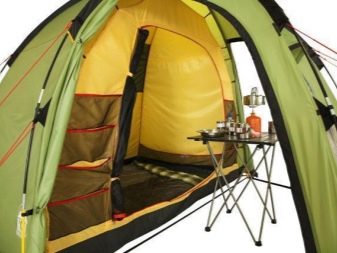

Advantages and disadvantages
Approximately half of the tents produced by the industry are produced with a vestibule, because there is a high demand for them. Let's try to figure out what are the pros and cons of such tents.
Advantages
Having an additional room in your tent is a very tangible convenience; it will never be empty on a hike. The advantages are as follows.
- In the vestibule you can store things that cannot be left without shelter, as they can get wet during an unexpected rain. Things will not occupy the bedroom, clothes and shoes will remain dry.
- In the waiting room you can sit out the bad weather.
- The kitchen is well equipped in a large vestibule.
- A tent with a dressing room has a higher level of ventilation.


Flaws
There are very few disadvantages of such a design, compared with the acquired comfort:
- the weight and dimensions of the tent increase slightly;
- cost increases with volume.
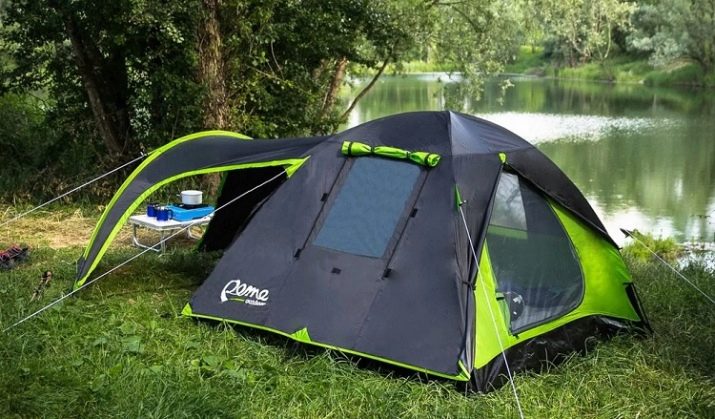
Kinds
Before buying a tent, you should know how it will be used. Tents with a vestibule can be for hiking, caravanning (camping), professional (trekking, extreme, expedition), for fishing, summer or winter. If the tasks are defined, you can proceed to the choice of purchase. Tents are of different types. They can be divided into 3 large groups:
- assault – the most weightless and compact;
- raid - for living with relative comfort of a small group of people;
- basic - for a long stay in nature in comfortable conditions, designed for a large group of people.
All 3 directions are also divided according to purpose, shape, number of layers, material, frame equipment. Fishermen, climbers, geologists and just tourists will need different types of tents.
In addition, there are tents for high mountains, middle mountains and plains.
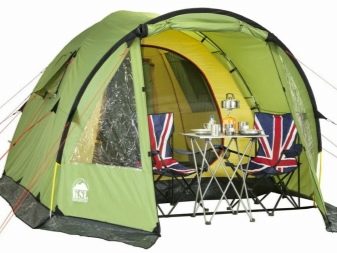
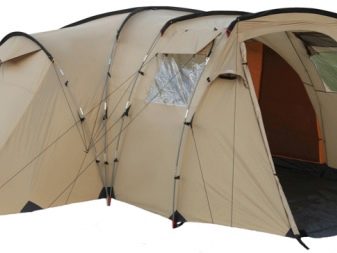
Alpine
These tents are professional equipment, they are of special quality and durability.They are not afraid of rain, strong winds, cold, significant heights above sea level, as they are designed for extreme conditions. Alpine models are divided into expeditionary and assault.
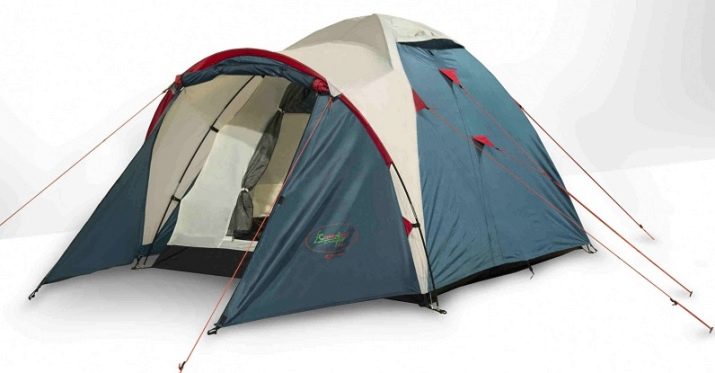
Expeditionary
Expedition tents are designed to form a base camp during the ascent, for thorough stops for several days. The designs of such models must be heavy-duty, rigid, warm, resistant to snow pressure, strong wind and rain.


Assault
Assault tents are taken by climbers who do not set up base camps for a long time, but rest in them as they get tired. The requirements for such models are somewhat different from the previous ones. The emphasis is on lightness and minimum capacity, since the tent has to be carried on oneself. At the same time, it should be warm, durable, windproof and moisture resistant.
Such equipment is assembled and disassembled as quickly as possible, but it is rarely equipped with a vestibule.
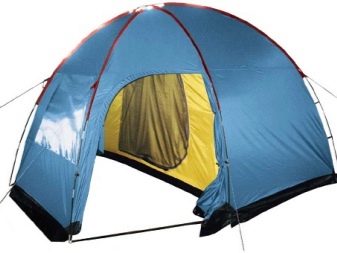
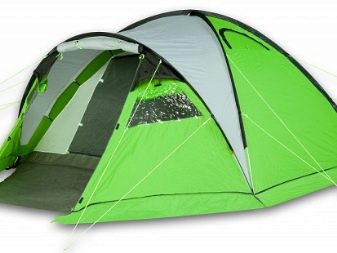
For midlands
Such tents are often used by non-professional tourists traveling in mountainous areas. Their equipment has absorbed the qualities of expeditionary and assault models. They are not as bulky as the first, and not as light as the second. These are more comfortable options, but just as resistant to bad weather as high-mountain ones.


plain
Plain tents are pitched in the forest and on open flat areas. There is a large selection of such products, as they come in different sizes, seasonal, designed for walking or driving. Below we consider options for flat models.

For hiking
These tents have to be carried for a long time. They must be very light and strong.A triple tent usually does not exceed the weight of 1.1 kg, a 5-person tent - 1.5 kg, an 8-person tent - 2.5 kg. They can be used for overnight stays in the forest, on the plains, along any hiking trails. They are not very comfortable and do not protect from rain and wind as well as professional tents.
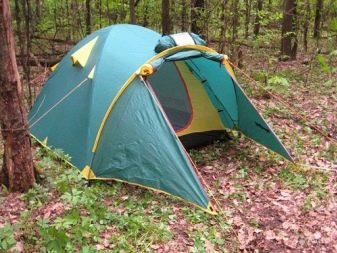
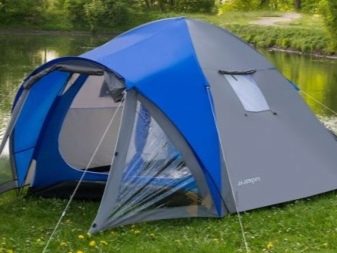
camping
This type of equipment can be large, as it does not have to be carried. These are tents of superior comfort and are designed for a long stay in nature. They can be two-room, three-room, family or just for a large company. For example, a 2-room apartment with a dressing room in the center or a 3-room apartment with two vestibules, a stove and a shed. Sleeping places are designed for a different number of people, and vestibules can accommodate a large amount of things.
Camping models have windows, good ventilation, they are high, they can be in full growth. The weight of such equipment reaches more than 7 kilograms. Assembling and disassembling a stationary tent is more difficult than an assault model. But it can have a large vestibule, which can really be used as a kitchen in rainy weather.
Universal tents are quite comfortable, they are not very stable in strong winds, but they are waterproof, made of breathable fabrics, have good ventilation, and do not collect condensate. Special tents are produced for special purposes, such as military, fishing, hunting or children's. The specificity of each type requires certain equipment.

By shape
Most often, tents are a frame covered with fabric. Frames model structures of various geometric shapes, which are responsible not only for the aesthetic appearance, but also for the practicality of the product.
hemisphere
The most popular type of tents, very easy to set up.Visually looks like half a ball. This form is often used for professional and tourist models. It is streamlined, protects well from rain and wind. A tambour is arranged at the entrance.

Half-ribbon
Outwardly, the tent resembles a barrel laid on its side, cut in half along its entire length. This is a very roomy form that can have several rooms, with a dressing room in the center. Although the vestibule of such a design can also be located from the end. The disadvantage of the model is the impossibility of disassembling it without an assistant and transferring it assembled to another place. But for a stationary camp, this is not considered a problem.
Camping tents often come in this shape.
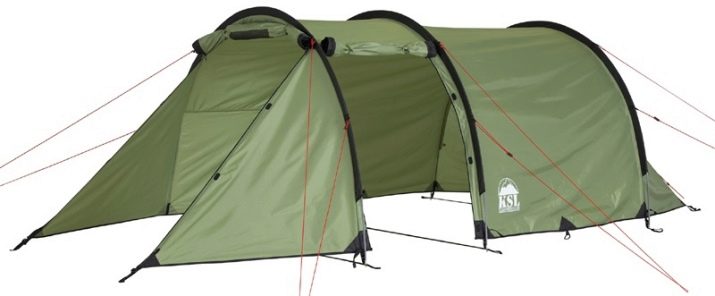
marquee
The tents look like a yurt. They are held on the same central post and on extensions from it, but there are other variations. Tents are large, without a floor, with windows or small, expeditionary, intended for hiking. Their advantages are that no need to wear disassembled frames. This type of tent was used in Soviet times. Large tents can be divided into a vestibule and a residential part.

"House"
Today you can find comfortable tents in the form of a house with a vestibule. But classically this species still belongs to the Soviet models. Often it is small, single-layer, backpack purpose. From the pros - has a low weight, miniature shape, lack of frame equipment, budget cost. Of the minuses - such models are difficult to install, they are poorly kept in the wind, and are suitable for perfectly flat terrain.


By season
For different seasons, weather conditions, temperature indicators, you need your own special tents.
- Summer. They are not designed for extreme weather conditions - thunderstorms, frost, hurricane winds.The tents are comfortable, made of breathable fabrics, have good ventilation, reasonable price.
- Winter. They are made of warm refractory materials, as they assume in their design the presence of a heating element in the form of a furnace.
- Three-season. Except winter, suitable for all seasons. Strong, tough, wind resistant. Can withstand heavy rain.
- All season. According to the requirements, they are the same as the three-season ones, but they have sloping shapes so that precipitation does not linger, as well as a snow skirt.

By design
By design, tents are single-layer or double-layer, with a frame or frameless. Let's consider each type separately.
Double layer
The most common type of tent. The structure is assembled from a frame and two types of coatings. The interior is made of lightweight, breathable fabric so light that it has no window openings. This layer is necessary to retain heat in the tent, with its help, condensation does not collect in the structure. The second layer is the outer layer, made of fabric that can withstand rain, wind and other weather troubles. The seams of this layer are processed, rubberized, do not let moisture through.
The outer layer is most often endowed with windows. They look like cellophane inserts or slits closed with special flaps made of tent fabric.

Single layer
Single-layer options are not equipped with a thin inner layer of fabric, so they keep heat worse, they have poor ventilation. Such models retain condensate, since the fabric of the tent does not allow wind and moisture to pass through, and therefore does not release evaporation to the outside. The industry is working to create a fabric that could protect the tent from drafts and rain, but would allow moisture to pass through to the outside.
There are already similar membrane fabrics on expensive products intended for extreme or sports tourism. Ordinary single layer tents have their own advantages, they are light, compact, easy to install and inexpensive.

Frameless
These are the lightest and most compact types of tents, they can weigh less than a kilogram. But you should not expect comfort from them, they can be partially blown by the wind, they are laid out a little more difficult than self-aligning ones. Such products solve certain problems when a hike is associated with heavy traffic or high speed, and every extra gram matters. Frameless tents can also be taken on short trips, just in case.


Frame
For such tents, in addition to the fabric cover, a collapsible frame is taken on a hike, on which the cover is stretched. The frame increases the weight of the equipment, but the comfort zone also increases. Two-layer tents do not let moisture and wind through, have good ventilation, sleeping places and are often equipped with a vestibule. The frames consist of small sticks inserted one into the other and connected by a common internal elastic band.
Arcs are assembled from folded sticks, on which loops of the tent cover are strung. When disassembled and packed, the frames take up little space, it all depends on the size of the tent and the material from which they are made.

How to choose?
The choice of a tent depends on the tasks that are set before it. For climbers, models for extreme ascents are suitable - Alexika Mirage 4 and Matrix 3. As a backpack option, you should choose Scout 3 or Rondo 4. For water or bicycle trips, you need tents with a large vestibule, for example, a “half-barrel”, where you can store sports equipment.For hunting and fishing, Tengu-type camouflage-patterned shelters are suitable. For a comfortable stay, you should choose models of the series Tengu MK1.08T3. Tent tents are ideal for kitchens; they are also equipped with a vestibule.
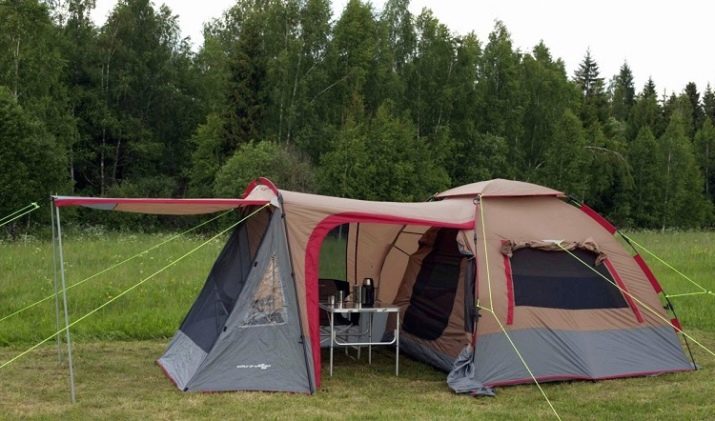
Whichever tent you choose, the tambour will always be an indispensable assistant on a hike and on vacation.
In the next video you will find a review of a two-room tent with a large vestibule Alexika Maxima 6 Luxe.




























